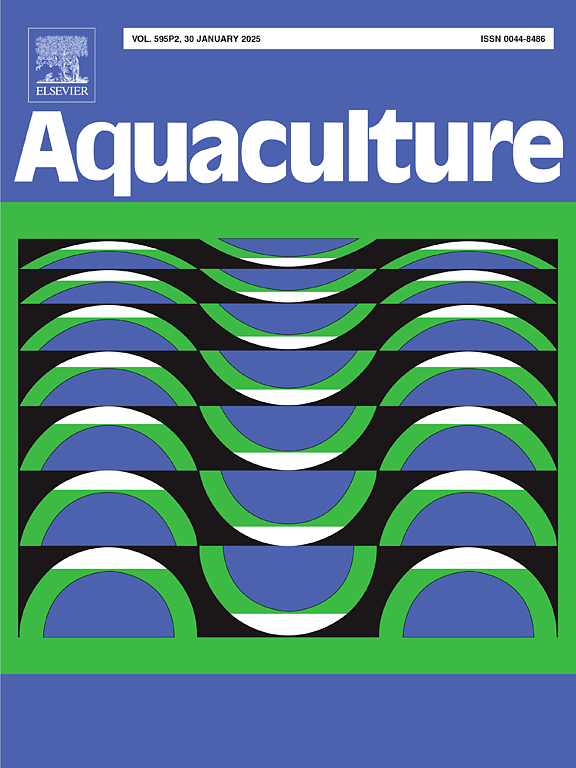The potential effects of inulin on lipid metabolism disorders in spotted sea bass (Lateolabrax maculatus) induced by a high-fat diet
IF 3.9
1区 农林科学
Q1 FISHERIES
引用次数: 0
Abstract
One green and eco-friendly feed additive that has been shown to reduce lipids in organisms is inulin (INU). This study sought to determine how adding INU to a high-fat diet (HFD) affected the spotted sea bass's (Lateolabrax maculatus) growth, digestion, and lipid metabolism. Six sets of three replicate fish each were created from a total of 360 disease-free, healthy spotted sea bass (Lateolabrax maculatus) weighing 2.35 ± 0.04 g, which were then housed in 18 culture tanks. The experimental spotted sea bass were fed the baseline diet (CK), high-fat diet (HFD) and HFD supplemented with 0.5 % INU(INU0.5), 1 % INU(INU1), 1.5 % INU(INU1.5) and 2 % INU(INU2), respectively, for 70 consecutive days. The results demonstrated that in comparison to the HFD group, dietary intake of INU significantly reduced the feed conversion ratio and adiposity in spotted sea bass. However, it did not exert a significant impact on specific growth rate (SGR), weight gain rate (WGR), or the activities of amylase (AMS) and lipase (LPS). Furthermore, compared to the HFD group, the INU group exhibited decreased serum levels of low-density lipoprotein cholesterol (LDL-C) and alanine aminotransferase (ALT) in spotted sea bass; additionally, there was a reduction in hepatic T-CHO and LDL-C content. Notably, both the HFD and INU groups demonstrated significantly elevated serum concentrations of total protein (TP) and albumin (ALB) compared to the CK group. Compared with the HFD group, the INU group demonstrated a reduction in liver fat vacuoles and ballooning degeneration, as well as a decrease in lipid droplet content in spotted sea bass. Additionally, INU (1 %,1.5 %,2 %) significantly downregulated the expression of ACC-2 genes, and significantly upregulated the expression of AMPKα genes. These results suggest that INU has the potential to regulate lipid metabolic disorders induced by HFD.
菊粉(INU)是一种绿色环保型饲料添加剂,已被证明可降低生物体内的脂质。本研究试图确定在高脂日粮(HFD)中添加 INU 对斑点叉尾鲈(Lateolabrax maculatus)的生长、消化和脂质代谢有何影响。从总重量为 2.35 ± 0.04 g 的 360 条无病健康斑海鲈中挑选出 6 组鱼,每组 3 条。实验用斑海鲈分别饲喂基线日粮(CK)、高脂日粮(HFD)和添加 0.5 % INU(INU0.5)、1 % INU(INU1)、1.5 % INU(INU1.5)和 2 % INU(INU2)的高脂日粮,连续 70 天。结果表明,与高纤维饲料组相比,摄入 INU 能显著降低斑点叉尾鲈的饲料转化率和脂肪含量。但是,它对特定生长率(SGR)、增重率(WGR)以及淀粉酶(AMS)和脂肪酶(LPS)的活性没有显著影响。此外,与 HFD 组相比,INU 组斑点叉尾鲈血清中的低密度脂蛋白胆固醇(LDL-C)和丙氨酸氨基转移酶(ALT)水平有所降低;肝脏中的 T-CHO 和 LDL-C 含量也有所降低。值得注意的是,与 CK 组相比,HFD 组和 INU 组的血清总蛋白(TP)和白蛋白(ALB)浓度均显著升高。与 HFD 组相比,INU 组的斑海鲈肝脏脂肪空泡和气球变性减少,脂滴含量降低。此外,INU(1 %、1.5 %、2 %)显著下调了ACC-2基因的表达,并显著上调了AMPKα基因的表达。这些结果表明,INU 有可能调节高密度脂蛋白胆固醇诱导的脂质代谢紊乱。
本文章由计算机程序翻译,如有差异,请以英文原文为准。
求助全文
约1分钟内获得全文
求助全文
来源期刊

Aquaculture
农林科学-海洋与淡水生物学
CiteScore
8.60
自引率
17.80%
发文量
1246
审稿时长
56 days
期刊介绍:
Aquaculture is an international journal for the exploration, improvement and management of all freshwater and marine food resources. It publishes novel and innovative research of world-wide interest on farming of aquatic organisms, which includes finfish, mollusks, crustaceans and aquatic plants for human consumption. Research on ornamentals is not a focus of the Journal. Aquaculture only publishes papers with a clear relevance to improving aquaculture practices or a potential application.
 求助内容:
求助内容: 应助结果提醒方式:
应助结果提醒方式:


